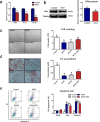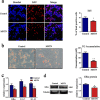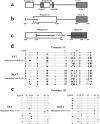Muscle-specific downregulation of GR levels inhibits adipogenesis in porcine intramuscular adipocyte tissue
- PMID: 28360421
- PMCID: PMC5428816
- DOI: 10.1038/s41598-017-00615-9
Muscle-specific downregulation of GR levels inhibits adipogenesis in porcine intramuscular adipocyte tissue
Abstract
Intramuscular adipose is conducive to good pork quality, whereas subcutaneous adipose is considered as waste in pig production. So uncovering the regulation differences between these two adiposes is helpful to tissue-specific control of fat deposition. In this study, we found the sensitivity to glucocorticoids (GCs) was lower in intramuscular adipocytes (IMA) compared with subcutaneous adipocytes (SA). Comparison of glucocorticoid receptor (GR) revealed that IMA had lower GR level which contributed to its reduced GCs sensitivity. Higher methylation levels of GR promotor 1-C and 1-H were detected in IMA compared with SA. GR expression decrease was also found in adipocytes when treated with muscle conditioned medium (MCM) in vitro, which resulted in significant inhibition of adipocytes proliferation and differentiation. Since abundant myostatin (MSTN) was detected in MCM by ELISA assay, we further investigated the effect of this myokine on adipocytes. MSTN treatment suppressed adipocytes GR expression, cell proliferation and differentiation, which mimicked the effects of MCM. The methylation levels of GR promotor 1-C and 1-H were also elevated after MSTN treatment. Our study reveals the role of GR in muscle fiber inhibition on intramuscular adipocytes, and identifies myostatin as a muscle-derived modulator for adipose GR level.
Conflict of interest statement
The authors declare that they have no competing interests.
Figures








Similar articles
-
Myostatin/SMAD4 signaling-mediated regulation of miR-124-3p represses glucocorticoid receptor expression and inhibits adipocyte differentiation.Am J Physiol Endocrinol Metab. 2019 Apr 1;316(4):E635-E645. doi: 10.1152/ajpendo.00405.2018. Epub 2018 Dec 21. Am J Physiol Endocrinol Metab. 2019. PMID: 30576242
-
Muscle Conditional Medium Reduces Intramuscular Adipocyte Differentiation and Lipid Accumulation through Regulating Insulin Signaling.Int J Mol Sci. 2017 Aug 20;18(8):1799. doi: 10.3390/ijms18081799. Int J Mol Sci. 2017. PMID: 28825638 Free PMC article.
-
Different regulation role of myostatin in differentiating pig ADSCs and MSCs into adipocytes.Cell Biochem Funct. 2012 Mar;30(2):145-50. doi: 10.1002/cbf.1828. Epub 2011 Nov 14. Cell Biochem Funct. 2012. PMID: 22081442
-
Effects of glucocorticoids on adipose tissue plasticity.Ann Endocrinol (Paris). 2024 Jun;85(3):259-262. doi: 10.1016/j.ando.2024.05.013. Epub 2024 Jun 12. Ann Endocrinol (Paris). 2024. PMID: 38871499 Review.
-
The function of myostatin in the regulation of fat mass in mammals.Nutr Metab (Lond). 2017 Mar 21;14:29. doi: 10.1186/s12986-017-0179-1. eCollection 2017. Nutr Metab (Lond). 2017. PMID: 28344633 Free PMC article. Review.
Cited by
-
ACAT2 Is a Novel Negative Regulator of Pig Intramuscular Preadipocytes Differentiation.Biomolecules. 2022 Jan 31;12(2):237. doi: 10.3390/biom12020237. Biomolecules. 2022. PMID: 35204738 Free PMC article.
-
Rno-miR-130b Attenuates Lipid Accumulation Through Promoting Apoptosis and Inhibiting Differentiation in Rat Intramuscular Adipocytes.Int J Mol Sci. 2025 Feb 7;26(4):1399. doi: 10.3390/ijms26041399. Int J Mol Sci. 2025. PMID: 40003868 Free PMC article.
-
Identification of differentially expressed genes and pathways between intramuscular and abdominal fat-derived preadipocyte differentiation of chickens in vitro.BMC Genomics. 2019 Oct 15;20(1):743. doi: 10.1186/s12864-019-6116-0. BMC Genomics. 2019. PMID: 31615399 Free PMC article.
-
Myostatin Alteration in Pigs Enhances the Deposition of Long-Chain Unsaturated Fatty Acids in Subcutaneous Fat.Foods. 2022 Apr 28;11(9):1286. doi: 10.3390/foods11091286. Foods. 2022. PMID: 35564009 Free PMC article.
-
Differential regulation of intramuscular fat and abdominal fat deposition in chickens.BMC Genomics. 2022 Apr 15;23(1):308. doi: 10.1186/s12864-022-08538-0. BMC Genomics. 2022. PMID: 35428174 Free PMC article.
References
-
- Hovenier R, Kanis E, Asseldonk TV, Westerink NG. Genetic parameters of pig meat quality traits in a halothane negative population. Livestock Production Science. 1992;32:309–321. doi: 10.1016/0301-6226(92)90002-L. - DOI
-
- Wang S, et al. Glucose utilization, lipid metabolism and BMP-Smad signaling pathway of porcine intramuscular preadipocytes compared with subcutaneous preadipocytes. Cellular physiology and biochemistry: international journal of experimental cellular physiology, biochemistry, and pharmacology. 2013;31:981–996. doi: 10.1159/000350116. - DOI - PubMed
Publication types
MeSH terms
Substances
LinkOut - more resources
Full Text Sources
Other Literature Sources
Molecular Biology Databases
Miscellaneous

